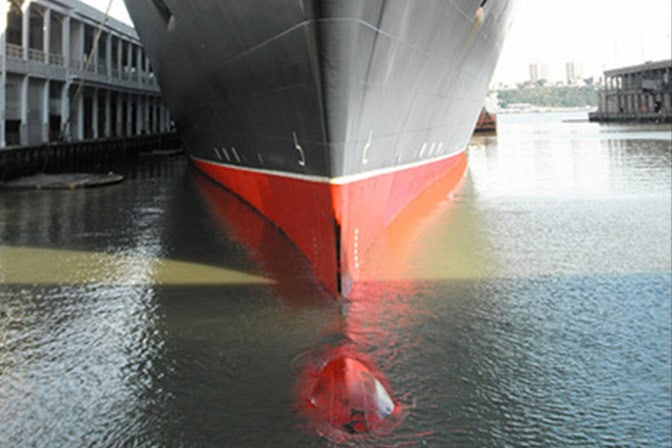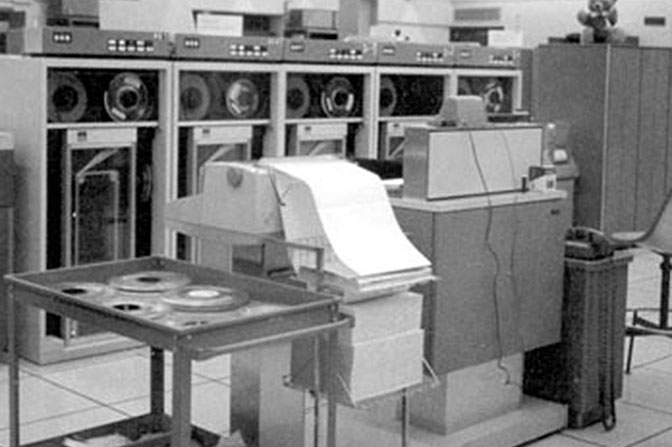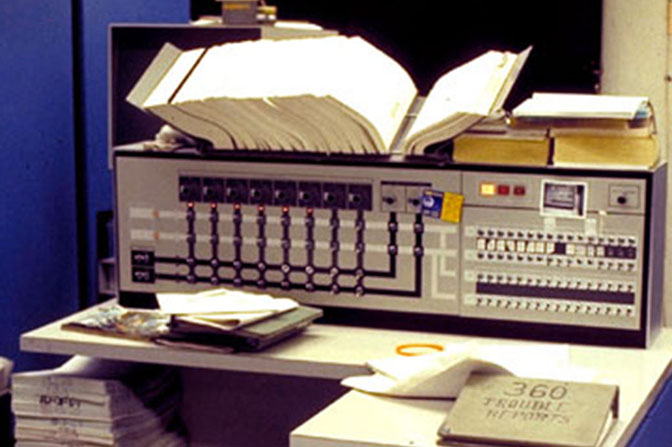
U-M researchers help design cost-saving bulbous bow
The bulbous bow, the punched card, and a new direction in ship design.

The bulbous bow, the punched card, and a new direction in ship design.
When future Michigan Engineer Art Reed failed French, he couldn’t have known that he was changing the future of naval architecture. The year was 1964, and the misstep scuttled Reed’s plans to start at U-M’s College of Engineering, studying naval architecture the following fall. Instead, he spent a year at Stevens Institute of Technology in Hoboken, New Jersey.

Explore more shipbuilding and maritime innovations from Michigan Engineering
Meanwhile at the University of Tokyo, legendary naval engineering researcher Takao Inui had just achieved something of a piece de resistance. His new waveless ship hull, known as the “bulbous bow,” had finally seen its first commercial application on a Japanese cargo ship, the Yamashiro Maru. The hull design incorporated a rounded protrusion at the front of the ship, below the waterline, that made the ship some 25 percent more fuel efficient than similar ships with traditional hull design. Inui’s bulb had initially drawn sneers from ship captains. Now, it was attracting the attention of naval architects around the world.
While it was clear that the bulbous bow worked, the details of exactly how and why were still murky. The bulb lowers resistance by partially canceling out the bow waves that push against a traditional hull as it plows through the water. But what was the ideal size and location of the bulb for a given vessel? And what was the best way to retrofit the bulbs to the thousands of cargo ships that were already plying the world’s waters? Nobody knew.

The University of Michigan’s naval architecture department was uniquely suited to provide answers. Its model testing basin in West Engineering was a good place to test iterations of the new design. Unlike many basins around the world, it wasn’t beholden to the military, so its flexible schedule made it just the place to test out radical new ideas.
At first, it was a bit of a free-for-all. One commercial shipper after another booked slots at the U-M tank, trying out their newest theories on bulb size, placement and other variables. Corning Townsend, a Michigan Engineer who worked at the tow tank in the 1960s, recalls that each test was a closely guarded secret.
“The energy companies like Texaco and Esso knew that this could earn them 6 or 7 percent more money on every load of oil, and each company had their own shape. They’d bring in their designs, the model makers would build a model, and we’d draw the shades and test it for things like resistance and self propulsion.”
It soon became clear that it was impossible to test each and every model. So researchers floated a new idea: what if bulbs could be optimized virtually, using computer models to predict how a given bulb configuration would behave in the water

At a time when data was still fed to computers on punch cards, this was a radical idea. On the other hand, U-M had just installed a new IBM 360/67, one of only two time-sharing mainframe computers in the world.
Also newly installed at U-M was Art Reed—he had been re-accepted to the naval architecture program after spending a year as an undergraduate at Stevens. He was keen to study hydrodynamics. And as it turned out, he couldn’t have picked a better time to flunk French. During his year-long detour he had learned Fortran, the computer language on which the new hydrodynamic models were to be based. U-M students at that time were still being taught Michigan Algorithm Decoder (or MAD), a proprietary language that was used only at U-M and would soon be phased out. Back at U-M, still an undergrad, he found himself working with a team of top experts on a project that would change the course of shipbuilding.
“It was very unusual to be doing something like this with computing and code,” Reed said. “And nobody else knew Fortran, so they were very anxious for me to get started.”
They ran test after test at the model basin to collect the data that would inform the new models. In those days, it was very much a hands-on experience. It also was an ambitious time of growth and improvement under the direction of the legendary Richard B. Couch, who had left his position as Chief Naval Architect with the Navy Department’s Bureau of Ships to become chair of NAME in 1957. Couch had emphasized graduate education, and in 1960 the first NAME Ph.D. was awarded to Finn Michelsen, a student from Norway, who stayed on to manage the model basin and would help to develop several more Ph.D. graduates in the following years.
Working with Michelson, the team dumped aluminum powder in the tank to make a reflective surface that enabled them to photograph the waves created during tests. They strung hot electrical wires beneath the water’s surface to measure the height of waves

Once the data was collected, it was Reed’s time to shine. He turned the raw data into a stack of paper punch cards that held the Fortran code for the new hydrodynamics models.
The new models were a success, helping to optimize countless bulbous bow retrofits on large shipping vessels. Today, bulbous bows are used on virtually all large commercial vessels, saving billions of gallons of fuel. And the code that Reed developed is still used today in wave analysis.
“It was an unbelievably great opportunity to work with experts like Som Sharma, Horst Nowacki, and Ramaswar Bhattacharyya,” Reed said. “It was a chance to work with exciting people who were doing state-of-the-art work, and we all became good friends.”
Indeed, Reed stayed at U-M for six more years after earning his undergraduate degree, ultimately earning a PhD and continuing his work at the U-M model basin. He moved to the U.S. Navy’s David Taylor Model Basin-Naval Surface Warfare Center in Bethesda, Maryland, in 1974 and still works there today.